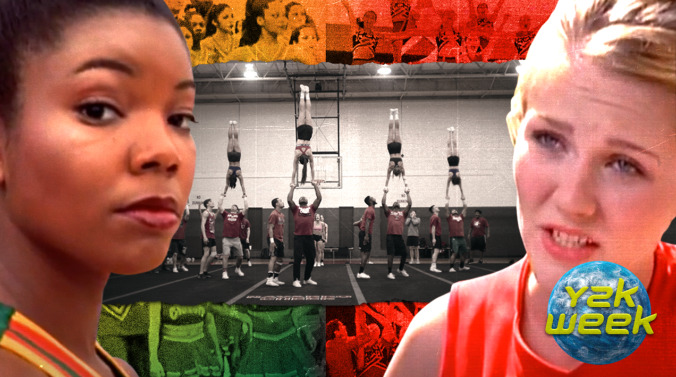They cheer and they lead: Bring It On ushered cheer culture into the mainstream

Imposing practice schedules, crunching bones, manipulation, politics, near-reckless ambition: Netflix’s Emmy-nominated docuseries Cheer beguiled audiences by stripping away cheerleading’s glossy veneer and instead centering on the athleticism, grit, and occasionally cutthroat attitudes of its participants. Training an unwavering lens on the Navarro College Bulldogs Cheer Team and its no-nonsense coach Monica Aldama, the runaway streaming hit served as the latest look at a fairly exclusive, highly competitive culture that was once so easily reduced to a few catchy chants and a pair a waving pom poms. Cheer harbored a very similar allure that rendered Bring It On an almost instantaneous classic 20 years prior, and it didn’t take long for critics to compare the two phenomenons—especially in their shared ability to bring cheerleading to the forefront of the viewing public’s collective consciousness.
Cheerleaders have long been a youthful fixture in Americana, often standing as an early emblem of popularity, wholesome values, and access. For many, donning the uniform meant being a part of an elite class, an interpretation that garnered as many detractors as it did fans. Within pop culture, that comparison translated into the cheerleader being sidelined as vague archetype or idea— either as a social goal, romantic conquest, or an enduring symbol of the status quo to vehemently reject—than fully realized characters and athletes. Whether they were objects of desire, like in 1987's Can’t Buy Me Love, or mean girls, à la Heathers, film and TV rarely delved beyond trope-y prototypes. Bring It On shifted the perspective in a significant way, positioning cheer culture squarely at the center of the narrative and nudging the sport into the mainstream. In screenwriter Jessica Bendinger’s teen comedy, the cheerleaders still played into certain stereotypes, whether that made them appear sexy, somewhat cutthroat, or unflinchingly bitchy—but it was by choice; they were also determined athletes and battle-tested champions.
Bring It On arrived at a time when competitive cheerleading was on a notable rise. As cable sports networks began to regularly air major high school cheerleading competitions, the general public became more privy to the sport’s fast-paced, complex showcases of gymnastic ability. It was a strong pivot from the toned-down, perfectly pleasant performances that graced most high school and community football fields. This also expanded society’s long-upheld vision of high school champions—a widely respected title largely saved for “traditional” (and predominately male) sports like football and basketball—to include these acutely cheerful competitors.
At the fictional Rancho Carne High School, the Toros cheerleaders, led by Torrance Shipman (Kirsten Dunst), had long surpassed the losing football team as the unquestionable stars on campus—evidenced by their six championship trophies. As Torrance herself explained to her soon-to-be teammate and ally Missy Pantone (Eliza Dushku), football games were merely practice runs, an opportunity to workshop winning routines in front of their adoring fans. Meanwhile, nameless football players receded to the background as sparsely seen caricatures meant to lob drive-by archaic barbs at the male cheerleaders. Soon after, Hollywood started to lean into the idea of a different social dynamic—that is, highlighting the accomplished cheerleader versus the unremarkable archetypal jock. In the decade to follow, Glee’s Cheerios and the titular squad in CW’s short-lived Hellcats followed Bring It On’s example, featuring cheerleaders with serious goals and ambitions far beyond homecoming queen or bolstering the confidence of their football counterparts.
But beyond representing the reality of competitive cheerleading, the mighty, mighty Toros also exhibited the need to advocate for a better, more equitable future for the cheer industry. Torrance and her tyrannical former leader Big Red (Lindsay Sloane) stood as deeply opposing, yet familiar versions of the same culture. Unrepentant in her proclivity to plagiarize the East Compton Clovers—the Toros’ Black rivals, led by the unrelenting Isis (Gabrielle Union)—Big Red’s seemingly normalized actions, and her remaining team’s listless reaction upon finding out about her fraudulent behavior, highlighted a widespread and largely accepted racial and class disparity that has existed in cheerleading since the late ’60s.
As is with any feelgood teen movie, the Toros have a change of heart and opt for originality and fair competition. And, to this day, Bring It On is largely praised for addressing and somewhat challenging the pervasive cultural appropriation within the sport. Though that praise is ultimately rendered ironic when you consider the final cut of the film came at the expense of its Black characters, as a sizable portion of the scenes and storylines involving the Clovers landed on the cutting room floor. Union has also been vocal about finding it “interesting” that fans often describe her character as the film’s villain. “The leader of a movement to make these suburban girls accountable for the theft of our hard work is called a villain?” the actress told Entertainment Weekly in 2018. “I think that’s very, very telling.”
Torrance and Missy stood for fairness and authenticity in their (at times) misguided attempts to course-correct after discovering Big Red’s wrongdoings. Their charitable efforts and successful final routine ultimately don’t result in a another championship win, and that’s a good thing. As a whole, the conflict between the Toros and the Clovers extended beyond one championship, and one good-faith routine was neither going to solve years of cultural encroaching nor eradicate the many barriers that continue to prevent underprivileged teams like the Clovers from regularly competing in these costly competitions. But their insistence on righting a few systemic wrongs almost felt like a dare of sorts two decades ago, a call for an industry to reevaluate its rise to prominence and make a concerted effort to be-e aggressively better.